人教版(2019)选择性必修第一册Unit 4 Body Language 单元整体设计说课课件(82张ppt)
文档属性
| 名称 | 人教版(2019)选择性必修第一册Unit 4 Body Language 单元整体设计说课课件(82张ppt) |  | |
| 格式 | zip | ||
| 文件大小 | 38.1MB | ||
| 资源类型 | 教案 | ||
| 版本资源 | 人教版(2019) | ||
| 科目 | 英语 | ||
| 更新时间 | 2022-09-12 13:49:52 | ||
图片预览

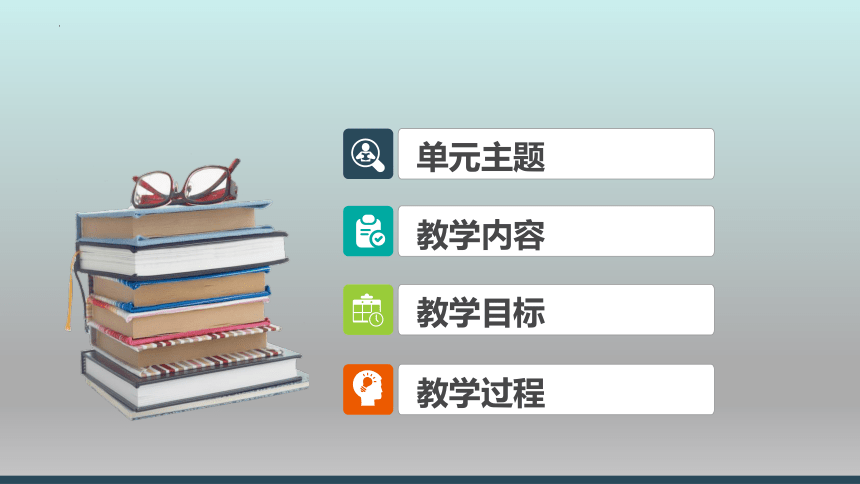
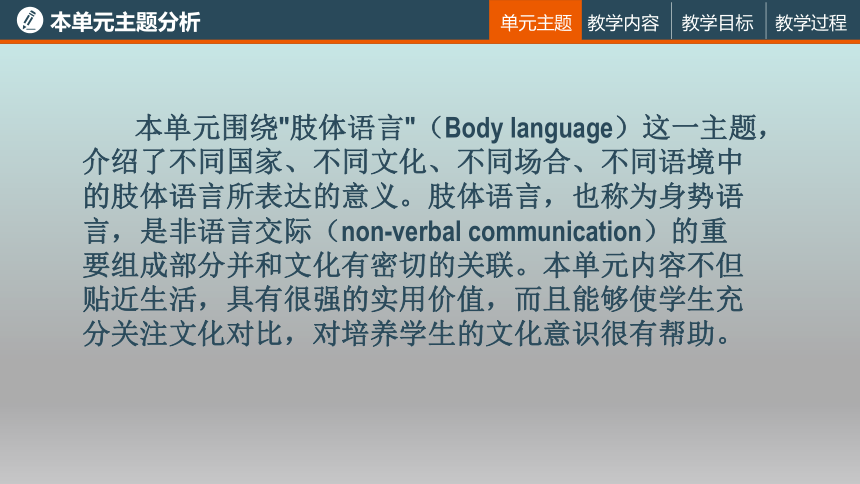
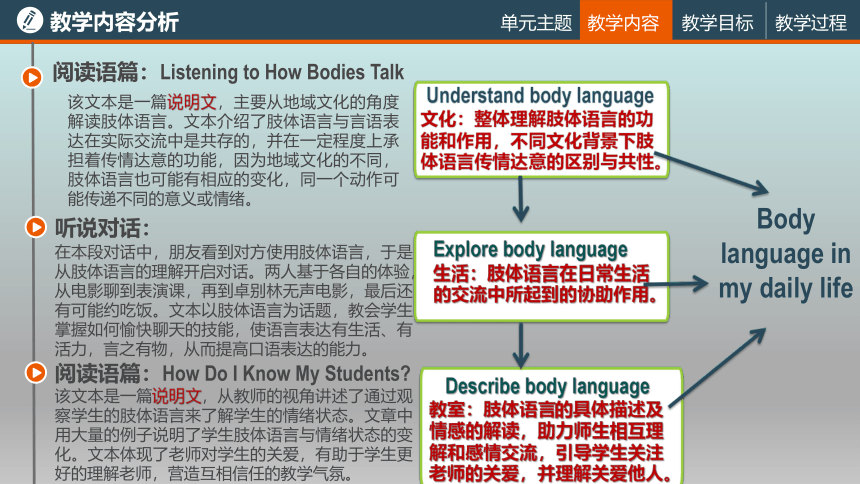

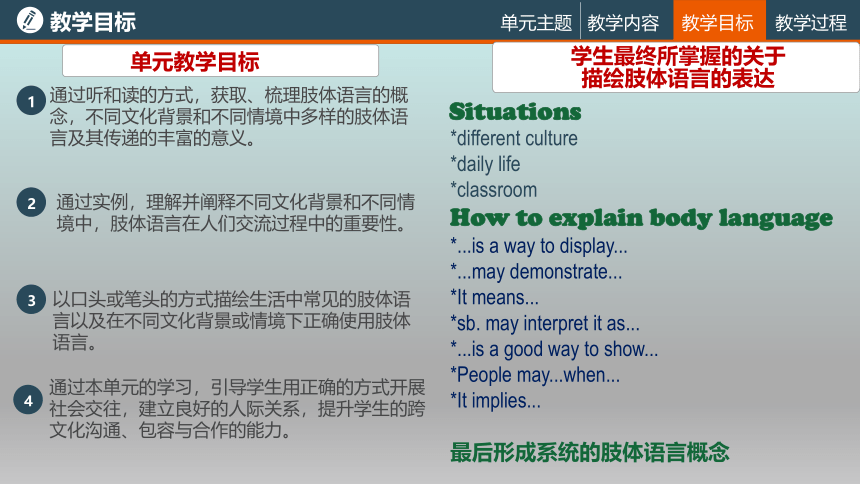
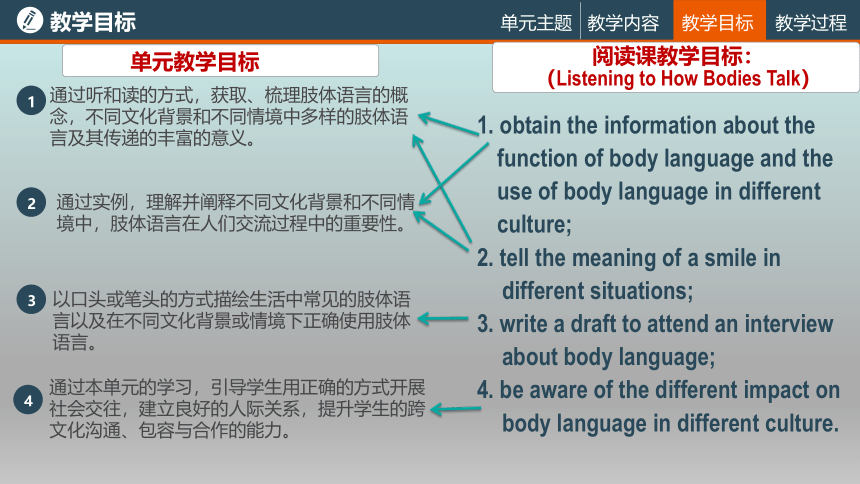
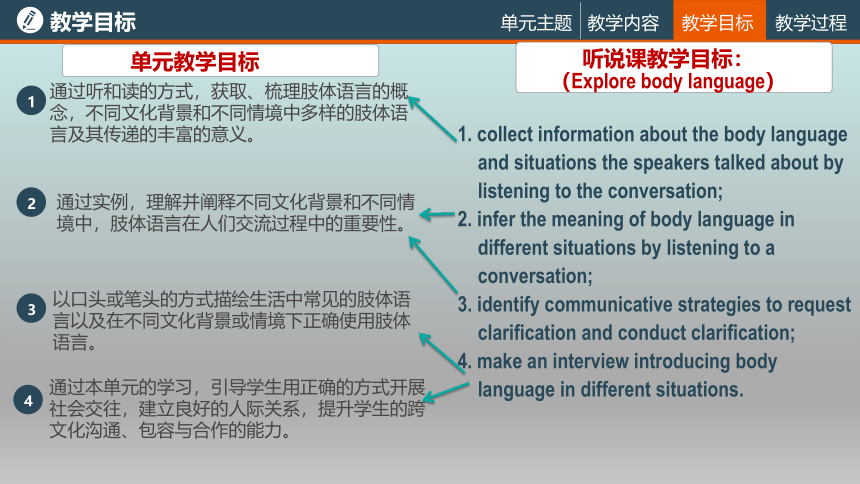
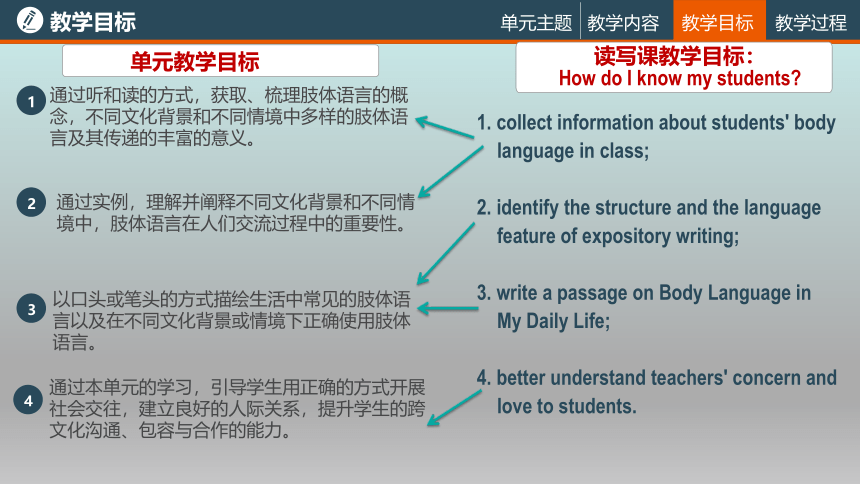
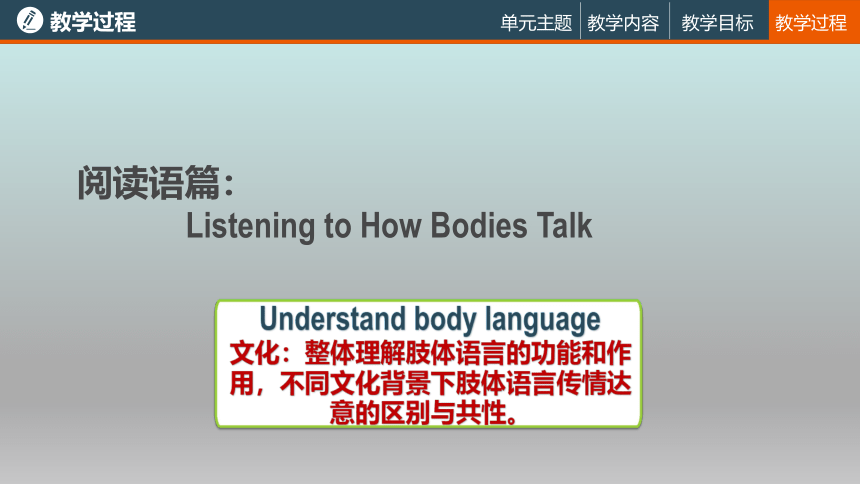
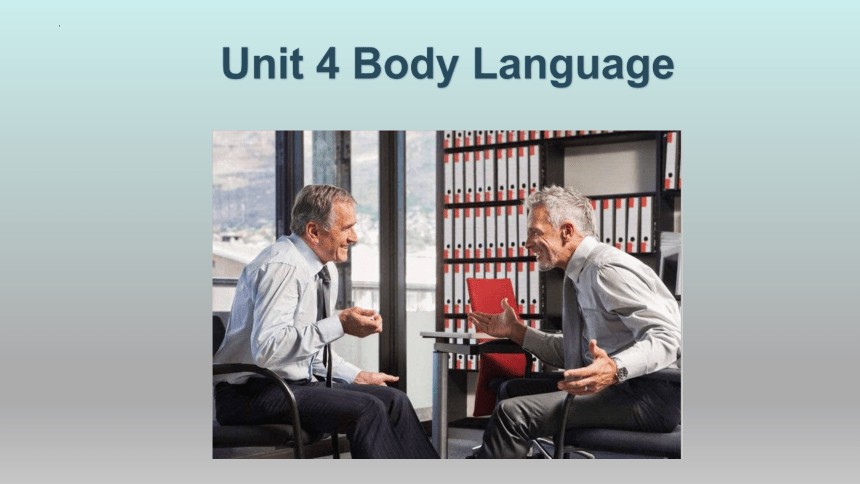

文档简介
(共82张PPT)
Book 1 Unit 4
Body Language
单元主题
教学内容
教学目标
教学过程
教学内容
教学目标
教学过程
单元主题
本单元主题分析
本单元围绕"肢体语言"(Body language)这一主题,介绍了不同国家、不同文化、不同场合、不同语境中的肢体语言所表达的意义。肢体语言,也称为身势语言,是非语言交际(non-verbal communication)的重要组成部分并和文化有密切的关联。本单元内容不但贴近生活,具有很强的实用价值,而且能够使学生充分关注文化对比,对培养学生的文化意识很有帮助。
教学内容
教学目标
教学过程
单元主题
教学内容分析
阅读语篇:Listening to How Bodies Talk
该文本是一篇说明文,主要从地域文化的角度解读肢体语言。文本介绍了肢体语言与言语表达在实际交流中是共存的,并在一定程度上承担着传情达意的功能,因为地域文化的不同,肢体语言也可能有相应的变化,同一个动作可能传递不同的意义或情绪。
听说对话:
阅读语篇:How Do I Know My Students
在本段对话中,朋友看到对方使用肢体语言,于是从肢体语言的理解开启对话。两人基于各自的体验,从电影聊到表演课,再到卓别林无声电影,最后还有可能约吃饭。文本以肢体语言为话题,教会学生掌握如何愉快聊天的技能,使语言表达有生活、有活力,言之有物,从而提高口语表达的能力。
该文本是一篇说明文,从教师的视角讲述了通过观察学生的肢体语言来了解学生的情绪状态。文章中用大量的例子说明了学生肢体语言与情绪状态的变化。文本体现了老师对学生的关爱,有助于学生更好的理解老师,营造互相信任的教学气氛。
Understand body language
文化:整体理解肢体语言的功能和作用,不同文化背景下肢体语言传情达意的区别与共性。
Explore body language
生活:肢体语言在日常生活的交流中所起到的协助作用。
Describe body language
教室:肢体语言的具体描述及情感的解读,助力师生相互理解和感情交流,引导学生关注老师的关爱,并理解关爱他人。
Body language in my daily life
教学内容
教学目标
单元主题
教学目标
教学过程
1
通过听和读的方式,获取、梳理肢体语言的概念,不同文化背景和不同情境中多样的肢体语言及其传递的丰富的意义。
2
通过实例,理解并阐释不同文化背景和不同情境中,肢体语言在人们交流过程中的重要性。
3
以口头或笔头的方式描绘生活中常见的肢体语言以及在不同文化背景或情境下正确使用肢体语言。
4
通过本单元的学习,引导学生用正确的方式开展社会交往,建立良好的人际关系,提升学生的跨文化沟通、包容与合作的能力。
学生最终所掌握的关于
描绘肢体语言的表达
Different body language
*make eye contact
*OK sign
*gestures for “yes” or “no”, “sleep”, “I am full”
*smile
*frown, tightly shut eyes, tight-lipped
*fingers crossed
*hug, embrace, American Sign Lanuage
*hold hands tightly
*lean forward and listen
*have one's head lowered
*look up
*with chins on their hands
*have arms crossed
*hide faces in hands
*brush one's hair
* ...
单元教学目标
教学内容
教学目标
单元主题
教学目标
教学过程
1
通过听和读的方式,获取、梳理肢体语言的概念,不同文化背景和不同情境中多样的肢体语言及其传递的丰富的意义。
2
通过实例,理解并阐释不同文化背景和不同情境中,肢体语言在人们交流过程中的重要性。
3
以口头或笔头的方式描绘生活中常见的肢体语言以及在不同文化背景或情境下正确使用肢体语言。
4
通过本单元的学习,引导学生用正确的方式开展社会交往,建立良好的人际关系,提升学生的跨文化沟通、包容与合作的能力。
学生最终所掌握的关于
描绘肢体语言的表达
Situations
*different culture
*daily life
*classroom
How to explain body language
*...is a way to display...
*...may demonstrate...
*It means...
*sb. may interpret it as...
*...is a good way to show...
*People may...when...
*It implies...
最后形成系统的肢体语言概念
单元教学目标
教学内容
教学目标
单元主题
教学目标
教学过程
1
通过听和读的方式,获取、梳理肢体语言的概念,不同文化背景和不同情境中多样的肢体语言及其传递的丰富的意义。
2
通过实例,理解并阐释不同文化背景和不同情境中,肢体语言在人们交流过程中的重要性。
3
以口头或笔头的方式描绘生活中常见的肢体语言以及在不同文化背景或情境下正确使用肢体语言。
4
通过本单元的学习,引导学生用正确的方式开展社会交往,建立良好的人际关系,提升学生的跨文化沟通、包容与合作的能力。
阅读课教学目标:
(Listening to How Bodies Talk)
1. obtain the information about the function of body language and the use of body language in different culture;
2. tell the meaning of a smile in different situations;
3. write a draft to attend an interview about body language;
4. be aware of the different impact on body language in different culture.
单元教学目标
教学内容
教学目标
单元主题
教学目标
教学过程
1
2
3
4
听说课教学目标:
(Explore body language)
1. collect information about the body language and situations the speakers talked about by listening to the conversation;
2. infer the meaning of body language in different situations by listening to a conversation;
3. identify communicative strategies to request clarification and conduct clarification;
4. make an interview introducing body language in different situations.
单元教学目标
通过听和读的方式,获取、梳理肢体语言的概念,不同文化背景和不同情境中多样的肢体语言及其传递的丰富的意义。
通过实例,理解并阐释不同文化背景和不同情境中,肢体语言在人们交流过程中的重要性。
以口头或笔头的方式描绘生活中常见的肢体语言以及在不同文化背景或情境下正确使用肢体语言。
通过本单元的学习,引导学生用正确的方式开展社会交往,建立良好的人际关系,提升学生的跨文化沟通、包容与合作的能力。
教学内容
教学目标
单元主题
教学目标
教学过程
1
2
3
4
读写课教学目标:
How do I know my students
1. collect information about students' body language in class;
2. identify the structure and the language feature of expository writing;
3. write a passage on Body Language in My Daily Life;
4. better understand teachers' concern and love to students.
单元教学目标
通过听和读的方式,获取、梳理肢体语言的概念,不同文化背景和不同情境中多样的肢体语言及其传递的丰富的意义。
通过实例,理解并阐释不同文化背景和不同情境中,肢体语言在人们交流过程中的重要性。
以口头或笔头的方式描绘生活中常见的肢体语言以及在不同文化背景或情境下正确使用肢体语言。
通过本单元的学习,引导学生用正确的方式开展社会交往,建立良好的人际关系,提升学生的跨文化沟通、包容与合作的能力。
教学过程
教学内容
教学目标
教学过程
单元主题
阅读语篇:
Listening to How Bodies Talk
Understand body language
文化:整体理解肢体语言的功能和作用,不同文化背景下肢体语言传情达意的区别与共性。
Unit 4 Body Language
*How do we communicate with others in our daily life
设计意图:通过问题激发学生已知,让学生体会肢体语言和有声语言一样是我们交流、表达情感、传递信息的重要手段。
活动层次:感知与注意
Warming up
What is body language
body movements, facial expressions, gestures, posture, speaking distance and other non-verbal signals.
non-verbal communication.
movements or
positions of our body to demonstrate what we are thinking or feeling.
It is a form of
It uses
It includes
设计意图:利用问题讨论肢体语言的定义和特点,并举例说明。
活动层次:描述与阐释;概括与整合
学生活动:借助所给问题,讨论肢体语言的特点,关注生词,同时举例说明。
Examples
Pre-reading
Listening to How Bodies Talk
设计意图:通过文本题目和插图推测文本主要内容。活动层次:感知与注意;描述与阐释;推理与判断
What is body language
What body languages are mentioned
学生活动:学生观察插图和文本题目,预测文本的主要内容。
然后带着两个问题进行第一遍阅读,思考什么是肢体语 言,文章中提及了哪些肢体语言。
*What is body language
Body language is a powerful communication system in all cultures, but body language can signal very different things in different cultures. So, it is very important to understand and use it correctly.
设计意图:验证预测,概括文章大意,对全文有总体了解
活动层次:概括与整合
While-reading
学生活动:学生进行第一遍阅读,验证预测,了解何为肢体语言。
*What body languages are mentioned
*make eye contact
*OK sign
*gestures for “yes” or “no”, “sleep”, “I am full”
*smile
设计意图:验证预测,梳理文章中出现的肢体语言,对全文有总体了解
活动层次:获取与梳理
While-reading
学生活动:学生进行第一遍阅读,验证预测,了解文章所涉及的肢体语言,同时引导学生关注肢体语言的定义。
Para.1
Para.2
Para.3
Para.4
Para.5
Para.6
Introduction to body language
What is the main idea of each paragraph
How do you know that
Body language varies from culture to culture.---eye contact
The gesture for OK has differetn meaning in different cultures.
Even the gestures we use for “yes” and “no” differ around the world.
some gestures seem to have the same meaning everywhere.
Some body language has many different uses.
be different
学生活动:学生在第一遍阅读后,根据每段的主题句,总结段落大意,同时了解说明文的行文特点。
Part1--Para.1
Part2--Para.2-4
Part3--Para.5
Part4--Para.6
Introduction to body language
Work out the structure of the text.
Body language with different meanings in different cultures
Body language with the same meaning everywhere
Body language with different uses
Different body language in different cultures or situations
学生活动:学生根据段落大意,进行归纳总结,将文章分为两大部分,第二部分又可分为三个不同方面;也可根据教参,直接分为四大部分,为精读做好铺垫。
Careful Reading part 1
1. What is the function of body language
设计意图:利用问题,引导学生获取信息,了解肢体语言的功能,同时关注首段结构,为写作铺垫
活动层次:获取与梳理
*We use both words and body language to express our thoughts and opinions in our interactions with other people.
* We can learn about what people are thinking by watching their body language.
学生活动:学生精读第一部分,了解肢体语言的功能:通过使用肢体语言传递信息和通过观察肢体语言来获取信息。同时处理这一部分的新词。
Careful Reading part 1
2. What is the function of the last sentence
设计意图:利用问题,关注首段结构,为写作铺垫
活动层次:概括与分析
It serves as a bridge to connect the sentence in front and lead into the new one.
What information about feelings can body language convey
学生活动:学生在问题引导下关注议论文首段末句的功能,连词but,also的作用。同时引出第二部分的阅读,即肢体语言如何传递信息和情感。
* What is the crucial thing in using body language
设计意图:用学过的单词解释生词,加强记忆
活动层次:获取与梳理,描述与阐释
Careful Reading part 2 (Para 2-4)
be suitable for
important
The crucial thing is using body language in a way that
is appropriate to the culture you are in.
Body language varies from culture to culture.
学生活动:学生精读第二部分,以People in different cultures do not adopt the same body language when conveying the same meaning, insead....引导学生说出该部分的主题句,了解不同文化背景下肢体语言通常是有区别的和使用肢体语言的关键所在是尊重文化,恰当使用。同时处理生词。
Careful Reading part 2 (Para 2-4)
How to use body language in a way that is appropriate to the culture
*Read para.2-4 and draw a mind map to demonstrate body language in different countries. (verb phrases)
--What body languages have been listed as examples [以下为追问,不出现在PPT中]
--What meaning does these body languages convey in different countries
--How to make eye contact in different countries
--What does the gesture for OK convey in different culture
--How to express Yes or No in differnt countries.
--How to greet each other in France and Rusia.
学生活动:让学生梳理不同文化背景下的肢体语言,优等生可以画思维导图,然后在问题的引导下,梳理补充思维导图,最后进行口头描述;弱一点的学生填写表格,在所给表达的支持下,对不同例子进行描述。
Careful Reading part 2 (Para 2-4)
How to use body language in a way that is appropriate to the culture
*Read para.2-4 and draw a mind map to demonstrate body language in different countries. (verb phrases)
学生活动方案一:让学生梳理不同文化背景下的肢体语言,优等生可以画思维导图,然后在问题的引导下,梳理补充思维导图,最后进行口头描述。
Making eye contact in some countries is a way.... In other countries, by contrast,...for example,...
Body language meaning country
Looking into one’s eyes
Looking down when talking to someone
*Body language should be appropriate to the country.
Taking eye contact as an example, how does looking into someone’s eyes vary in different cultures
设计意图:通过阅读,找出肢体语言三个特点
活动层次:获取与梳理,描述与阐释
Display interest
Be not approved of
Some country
Middle East
Demonstrate respect
Japan
学生活动方案二:让学生梳理不同文化背景下的肢体语言,两人一组借助提示词练习,然后全班分享,同时处理生词。(要求学生按照所给原文框架,用完整句子回答。)
gesture meaning country
OK sign
*The identical gesture “OK” has different meanings in different cultures.
In ..., some who witness...might think...
In ..., a person encountering...may interpret it as....
In ..., you should...as it is ...
money
Japan
zero
France
impolite
Brail and Germany
*Same meaning is expressed by different gestures.
meaning gesture country
Yes
No
greetings
nodding
Many countries
Shaking head
Bulgaria southern Albania
Shaking head
Bulgaria southern Albania
nodding
Many countries
Kissing on the cheek
France Russia
Shaking hands
Bowing from the waist
Nodding
Elsewhere
*What expressions are used when explaining the meaning of different body language
*...is a way to display...
*...may demonstrate...
*It means...
*sb. may interpret it as...
*...have the opposite meaning...
*People may...when...
学生活动:让学生梳理解释肢体语言可以使用的表达,内化后,为后期写作做准备。
*How is the body language mentioned in the text interpreted in China
-Eye contact between men and women
-Looking down when talking to someone OK sign
-Kissing on the cheek
-Placing your hands together and resting them on the side of your head while closing your eyes
-Moving your hand in circles over your stomach after a meal
Some are the same in China. For example, the gesture for putting hands together and resting them on the side of your head means sleeping.
*...is a way to display...
*...may demonstrate...
*It means...
*sb. may interpret it as...
*...have the opposite the meaning...
*People may...when...
学生活动:让学生利用所梳理的表达,迁移,解释表格中肢体语言在中国所表达的含义。
*Can you think of an example of body language that is appropriate in China but might be misunderstood in another culture
Avoiding eye contact and lowering one's head may mean respect and being shy in China, whereas in some other countries this body language may be interpreted as being rude.
设计意图:通过表达,灵活运用所获取的信息和表达。
活动层次:内化与运用,描述与阐释。
学生活动:学生结合国内和国外文化特点举例说明肢体语言使用上可能会出现的差异,引导学生将来使用肢体语言交流时,做到恰当,理解并尊重文化差异。
Careful Reading Part 3(Para5)
*Some gestures seem to have the same meaning everywhere.
*Can you find any examples in Para.5
设计意图:阅读中查找信息,了解一些手势在不同文化背景下具有相同的意义
活动层次:获取与梳理
Sleeping:
I am full:
Placing your hands together and resting them on the side of your head while closing your eyes.
Moving your hand in circles over your stomach after a meal.
学生活动:学生阅读第三部分,了解虽然不同文化背景下人们使用的很多肢体语言不同,但也一些肢体语言在很多国家有着相同的意义,学生们阅读后举例说明。
Careful Reading part 4(para 6)
Different uses of smilling
*Experts suggest...
设计意图:阅读中查找信息,发挥想象,阐述微笑的其他作用
活动层次:获取与梳理,创造与想象
What are other uses of smiling
Sometimes some body language has different uses. Can you give an example
*Smile can help us... and find ...
*A smile can ...
*We can use a smile to...
*...there is nothing better than seeing...
*...
学生活动:学生阅读第四部分,了解一个肢体语言在不同情境下可以有不同的意思,最后引导学生思考除了以上所提到的,smiling可以表达的其他的意思和功能。
Smile Trial-P.39-Ex.4-拓展
设计意图:通过视频,引导学生关注微笑在不同情境下传递的不同意义或情绪
活动层次:获取与梳理,描述与阐释
What are other uses of smiling
学生活动:此部分为选做,学生可以在以上讨论的基础上,继续观看视频,了解微笑背后隐藏的秘密。
Smile Trial
设计意图:通过视频,引导学生关注微笑在不同情境下传递的不同意义或情绪
活动层次:描述与阐释,批判与评价
1. Smile can be used to hide feelings like anger, fear, or worry. Can you describe a situation where you might smile when you don't mean it
Sometimes I smile when I am impatient, but I know I shouldn't be. For example, if I am riding a train and a baby starts crying, I may try to smile, because even though the baby's crying is annoying, I know that it is not the baby's fault and there is probably nothing that can be done.
学生活动:此部分为选做,学生可以在以上讨论的基础上,继续观看视频,了解微笑背后隐藏的秘密。
Smile Trial
设计意图:通过视频,引导学生关注微笑在不同情境下传递的不同意义或情绪
活动层次:描述与阐释,批判与评价
2. Apart from fake smiles, is there any other kind of body language that can sometimes be fake
There are"crocodile tears".This is when a person fakes feeling sad or sympathetic for another person.
(The phrase comes from an old story that crocodiles cry while they are eating, as though they feel sad for their victim.)
学生活动:此部分为选做,学生可以在以上讨论的基础上,继续观看视频,了解微笑背后隐藏的秘密。
Discussion --拓展
设计意图:通过讨论,让学生思考文字语言和肢体语言在表达人真实感受时的作用。
活动层次:内化与运用,批判与评价
Which is a more reliable guide for understanding someone's feeling, their body language or the words they speak
Their body language is much more reliable than the words they say, because most people have trouble hiding their anger, disappointment, or iritation.
学生活动: 在观看了视频和进行讨论之后,学生可以继续辩证思考,到底是肢体语言还是人们所说的语言更让人值得信赖,答案不唯一,有理有据,自圆其说就好。
Listening to How Bodies Talk
设计意图:整体回顾文本内容,并探讨内容和标题的关系。活动层次:内化与运用,批判与评价。
学生活动:让学生回归文本的标题,让学生阐述How do bodies talk How to listen to bodies talk 同时引导学生关注标题的修辞手法使用。
Retorical device: personification
Do you like the title
What retorical device is used
Post-reading
Suppose you are going to attend an interview, prepare a draft with the help of the outline questions.
设计意图:通过准备采访稿,总结文本呈现的主要内容,也为第二节听说课输出的对话和第三节读写课的输出做语言准备。
活动层次:内化与运用
Homework
*What is the function of body language ?
*What is the use of body language in different culture?
*Why should we learn body language?
教学过程
教学内容
教学目标
教学过程
单元主题
听力语篇:
Explore body language
生活:肢体语言在日常生活的交流中所起到的协助作用。
Review
Unit 2 Body language
Using language
Review
*What is the function of body language?
—We use both words and body language to express our thoughts and opinions in our interactions with other people.
—We can learn a lot about what people are thinking by watching their body language.
学生活动:借助问题,回顾上节课所学内容。
Hello! Good-bye! Come here! Go away! Too expensive
I'm surprised! I'm tired. I'm confused. OK! Good luck!
I'm happy! I'm upset! I'm sad! I forgot! You're great!
Act out
What kind of language has been used in students' performance
设计意图:体会肢体语言的表意功能,活跃课堂气氛,加强互动
活动层次:感知与注意;描述与阐释
学生活动:请三名同学用动作(肢体语言)展示表格中的表达,让学生体会日常交流中肢体语言的使用。
表演后板书:facial expression: smile, mouth wide-open, frown,…. gesture: waving one's hand, thumb up, clench one's fists,….
Before listening
设计意图:唤起学生已知,进一步激发学生兴趣;
活动层次: 分析与判断,描述与阐释。
*What emotion is each person conveying
*...is a way to display... *...may demonstrate...
*It means... *sb. may interpret it as...
*...is a good way to show... *People may...when...
学生活动:请同学们两人一组,根据图片和所给表达,描述图片中人物的肢体语言所传递的意义,其中所给提示的表达来自于前一课阅读文本中的表达,此环节既在新情境中复习了上节课内容,同时也为听力理解做了铺垫。
设计意图:唤起学生已知,进一步激发学生兴趣;
活动层次: 分析与判断,描述与阐释。
*...is a way to display... *...may demonstrate...
*It means... *sb. may interpret it as...
*...is a good way to show... *People may...when...
Body language Meaning
frown , tightly-shut eyes , tight-lipped in great pain
* What emotion is each person conveying
设计意图:唤起学生已知,进一步激发学生兴趣;
活动层次: 分析与判断,描述与阐释。
*...is a way to display... *...may demonstrate...
*It means... *sb. may interpret it as...
*...is a good way to show... *People may...when...
Body language Meaning
fingers crossed good luck
*What emotion is each person conveying
设计意图:唤起学生已知,进一步激发学生兴趣;
活动层次: 分析与判断,描述与阐释。
*...is a way to display... *...may demonstrate...
*It means... *sb. may interpret it as...
*...is a good way to show... *People may...when...
Body language Meaning
hug , embrace , American Sign Language ( hand gesture for love ) love
*What emotion is each person conveying
设计意图:唤起学生已知,进一步激发学生兴趣;
活动层次: 分析与判断,描述与阐释。
*...is a way to display... *...may demonstrate...
*It means... *sb. may interpret it as...
*...is a good way to show... *People may...when...
Body language Meaning
smile , hold hands tightly friendly
*What emotion is each person conveying
*What is the relationship of the speakers
*What have been talked about in the conversation
设计意图:引导学生整体关注对话,厘清人物关系和谈论的主要内容。
活动层次:获取与梳理。
While listening-First listening
They are friends or classmates.
They are talking about body language used in different situations.
学生活动:学生听第一遍听力,梳理人物关系和对话主要内容,关注谈论到的不同情境下肢体语言的使用。
*Meeting sb. for lunch
*An action movie
*Taking acting classes
*Charlie Chaplin movies
设计意图:引导学生关注不同情境下对肢体语言的讨论,通过笔记梳理信息。
活动层次:获取与梳理。
While listening-Second listening
What situations have been mentioned in the conversation
学生活动:学生进行第二遍听力,关注哪些关于肢体语言的具体话题或情境出现在对话中,为引导学生进行第三遍听力做准备。
1.How did the man tell his classmates to meet him to have lunch
2.How did he got the idea to use the gesture
3.What did the police do in the movie Why did they use these body languages
4.What does the woman learn in the acting class
5.How does she think of body language
6.Why did they talk about Charlie Chaplin movies (remind... of..)
7.What do they think of Charlie Chaplin
8.What did the man mean by saying "It's good you tried" at the end of the conversation 【此处做学案】
设计意图:引导学生关注不同情境下对肢体语言的讨论,通过笔记梳理信息。
活动层次:获取与梳理。
While listening-Second listening
学生活动:在学生精听并做完笔记后,教师通过问题和追问以及听力录音,帮助学生梳理笔记,了解对话中两人所谈论的不同情境下的肢体语言。检查学生是否纪录下关键信息。(这一页为教师追问问题,不必出现在上课PPT上)
While communicating with others, we may :
*ask questions,
*explain,
*respond to the explanation,
*bring up a new topic...
How did the two speakers
develop their conversation
学生活动:学生在教师的引导下思考本段对话和日常交流中常见一些交流方式,为第三遍听力做准备,引导学生关注询问、解释、转移话题的相关表达。
Woman: What were you doing just now What did those gestures mean
Man: Oh, I was just telling my friend over there to meet me for lunch down the street in twenty minutes.
Woman: Oh, I get it, so you were sending him secret hand signals.
Man: Yeah, we got the idea from an action movie last night and decided to try it out for fun. In the movie, the police were trying to enter a house, but they had to be really quiet so they could take the criminals by surprise. So, the police leader used hand gestures to tell his team what to do. For example, he used this gesture to tell them how many bad guys were in the house Then he gave instructions on who should go where, and what they should do. I thought it was pretty cool how they used hand gestures to communicate.
Woman: Well, you know, you can say a lot without speaking. I've been taking acting classes, and right now we're learning how to use body language to express ourselves.
Man: Wow, that's cool. So you mean you're not allowed to talk, right
Woman: Yes, and it's really difficult if they want you to express something complicated without saying a word. But I‘m slowly getting better at it, I guess.
Man: That reminds me of those Charlie Chaplin movies. I guess it‘s not easy to tell a whole story only using body language.
woman: Yeah, he was a real master. Everyone in my class loves his movies. We actually had to watch some of his movies and act out some scenes. I was such an amateur!
Man: Well, it's good you tried. Now, by your body language, I can tell that you want to buy me lunch tomorrow. Am I right
Asking for and giving clarificatioin
设计意图:梳理请求澄清和澄清的表达;
活动层次:获取与梳理。
While listening
-3rd listening
学生活动:通过听力录音,梳理对话中所使用的询问、解释,以及自然转换话题的功能句,活动形式为听力填空。
Asking for and making clarification
What did you mean by... So you mean … So did that mean ... What I don’t quite understand is ... Could you explain… Could you give me an example In other words ...
What I meant was ...
What I was trying to say was ...
Does that make sense
Is that clear
I can tell that ...
Use the table below to clarify any misunderstandings or different answers.
学生活动:经过上一环节的梳理后,利用书中所给表格,总结询问和澄清时可使用的表达。
Suppose you are attending an interview, make a conversation with the outline questions and the expressions to ask for and make clarification.
After listening
设计意图:学生根据已有认知及本课对话获取的信息,通过两人一组的对话进行关于肢体语言的讨论。
活动层次:内化与应用,迁移与创新。
*Do you think body language is common in our daily life?
*What is the function of body language ?
*Could you give an example to explain the use of body language in different situations?
学生活动:这一环节为上一课阅读课的延伸,上一节课以书写的形式阐述了肢体语言的功能和不同文化背景下的使用,而本节课则依然以肢体语言的功能和使用为话题,以口头对话的形式,进一步讨论肢体语言的功能和不同情境下肢体语言的使用,举例时让学生以所给图片为依据,进行描述和阐释。
Polish the conversation you made in class.
设计意图:学生结合课上所学和课上准备的对话,以书面的形式呈现出来,对所学内容进行内化与巩固。
活动层次:内化与应用,迁移与创新。
Homework
教学过程
教学内容
教学目标
教学过程
单元主题
读写语篇:
How Do I Know My Students?
Describe body language
教室:肢体语言的具体描述及情感的解读,助力师生相互理解和感情交流,引导学生关注老师的关爱,并理解关爱他人。
1. What is the function of body language?
*We use both words and body language to express our thoughts and opinions in our interactions with other people.
*We can learn a lot about what people are thinking by watching their body language.
设计意图:复习肢体语言的功能。
活动层次:感知与注意;描述与阐释。
学生活动:学生通过回答问题,复习肢体语言的功能,为文本阅读和写作做准备。
2. What emotion does different body language convey?
Body language Meaning
frown, tightly shut eyes, tight-lipped in great pain
Body language Meaning
fingers crossed good luck
学生活动:学生通过回答问题和图片描述,复习生活常见的肢体语言和其表达的意义、传递的情感,为文本阅读和写作做准备。
*...is a way to display... *...may demonstrate...
*It means... *sb. may interpret it as...
*...is a good way to show... *People may...when...
Body language Meaning
hug, embrace, American Sign Lanuage(hand gesture for love) love
2. What emotion does different body language convey?
Body language Meaning
smile, hold hands tightly friendly
*...is a way to display... *...may demonstrate...
*It means... *sb. may interpret it as...
*...is a good way to show... *People may...when...
说明:
以上句型/短语都来自于第一篇课文,学生用所学过的语言第二次描述新的肢体语言。用这种形式内化语言。
例如:
*Frowning, tightly shutting eyes, or being tight-lipped may demonstrate that people are in great pain.
*Having fingers crossed is a good way to show good luck.
*When people, hug, embrace, or use American Sign Lanuage (hand gesture for love), they are expressing their love.
*Smiling, holding hands tightly means people are friendly.
3. Some language has different uses.
*A smile can help us get though difficult situations.
*A smile can help us find friends in a world of strangers.
*A smile can break down barriers.
*A smile can be used to apologise, to greet someone, to ask for help, to start a conversation.
*A smile can bring yourself happiness and strength, at the same time get rid of sadness and loneliness.
学生活动:学生通过举例,复习生活常见的肢体语言在不同情境下所表达的意义、传递的情感,为文本阅读和写作做准备。
*As a student, what dfferent feelings have you ever experienced in class
*What will you do when you feel...
diffrent feelings
(meanings)
interested
bored
amused
distracted
troubled
anxious
confused
设计意图:学生展开头脑风暴,为接下来的读写活动在话题和语言上做好铺垫。
*How does a teacher know what's going on in the minds of his/her students
活动层次:感知与注意;描述与阐释
学生活动:学生结合自身,谈论课堂常见的情感和其肢体语言的体现,从而导入文本阅读.
*What will be talked about in the text
设计意图:学生根据语篇标题和插图预测语篇内容。
“HOW DO I KNOW MY STUDENTS”
活动层次:描述与阐释;推理与判断。
*Read the text, check your prediction and summarize the main idea of each paragraph.
*What is the function of each paragraph
Para.1
Para.2
Para.3
Para.4
Para.5
Para.6
Introduction
Recognise when students are interested or bored
Recognise when students are distracted
Distinguish when students are troubled
Conclusion
Part 1
Part 2
Part 3
设计意图:阅读语篇,验证推测,总结大意。
活动层次:获取与梳理;概括与整合。
*Is it easy for the teacher to comunicate with each student in class
*How does the teacher know her students
*What is the function of Part 1
*Introduce the topic.
*Arouse readers' interest as a “hook”.
As an educator, people often ask me how I know what is going on in the minds of my students. Many students are quite shy and don't speak all that much. At the same time, in a classroom of more than forty students, it is hard to have many one-on-one conversations with each person. So, how can I really know what makes each student tick
My answer I look at their body language
*Introduce the background.
学生活动:学生阅读第一部分,了解教师为什么通过观察肢体语言了解学生。同时关注tick的表达意义和本段在整篇文章中的作用。
方案一:
此环节可让学生绘制思维导图,梳理以动词短语为主的表达,引导学生观察说明文的语言特点,为稍后的写作输出做铺垫。
方案二:
此环节也可让学生在阅读的同时填写学案上的表格,梳理相关动词短语,为写作输出做准备。
*Read Para.3-5 and summarize the expressions on body languages that show different meanings or emotions.
*How does the teacher know students
*Read Para.3-5 and summarize the expressions on body languages that show different meanings or emotions.
*Interested
*Bored
*Distracted
*Be troubled
*How does the teacher know students
设计意图:阅读语篇,获取表达不同情感的肢体语言的描写。
活动层次:获取与梳理。
学生活动:学生阅读文本第二部分,梳理学生课上常见的情绪和体现的肢体语言。
*Read Para.3-5 and summarize the expressions on body languages that show different meanings or emotions.
*Interested
*How does the teacher know students
-tend to look up and make eye contact
-smile
-lean forward and look at ...
-People have a tendency to lean towards whatever they are interested in.
*Read Para.3-5 and summarize the expressions on body languages that show different meanings or emotions.
*How does the teacher know students
-He has his head lowered to look at his watch
-Some students look up, but there is an absence of eye contact. Their eyes barely move, and they always have the same distant expression on their faces. It is as though they are asleep with their eyes open.
*Bored
*Read Para.3-5 and summarize the expressions on body languages that show different meanings or emotions.
*How does the teacher know students
-spend all their time looking anywhere but at me.
-daydreaming:With their chins on their hands, they occupy themselves by staring out of the window or up at the ceiling.
*Distracted: be amused by something else
Reminding distracted students that they need to pay attention in class.
*Read Para.3-5 and summarize the expressions on body languages that show different meanings or emotions.
*How does the teacher know students
-have their arms crossed in front of their chests and their legs closed or crossed, like they are guarding their bodies.
*troubled: angry, afraid, or experiencing anxiety
*troubled: sad or worried
-wear a frown; hide their faces in their hands; brush her hair and her eyes are red from weeping
I need to inquire and assess what is going on.
*Read Para.3-5 and summarize the expressions to explain/ interpret the body language.
*It is easy to recognise when...
*When I talk about..., they...
*People have a tendency...
*They are probably...
*It implies...
*How does the teacher interpret Ss' body language
*It is easy to perceive...
*It is easy to distinguish...
*I can infer that ...
*It chould be that ...
设计意图:阅读语篇,获取解释肢体语言所传递情感、意思的相关表达。
活动层次:获取与梳理。
学生活动:学生阅读文本第二部分,梳理解释肢体语言意义时使用的表达,为写作做准备。
*What are these people doing
*What is their body language telling you
*How does the teacher interpret their body language
设计意图:利用所学表达描述图片中人物的动作及其表达的意义。
活动层次:内化与运用,描述与阐释
学生活动:学生借助所学,描述图片中学生的动作和传递的情感,为写作做准备。(此环节第三次复现第一篇课文里所使用的表达,和本节课所总结的表达,描写新的肢体语言或表情,也可在教参基础上补充)
*...is a way to display... *...may demonstrate...
*It means... *sb. may interpret it as...
*...is a good way to show... *People may...when...
*It is easy to recognise when...
*When I talk about..., they...
*People have a tendency...
*They are probably...
*It implies...
*It is easy to perceive...
*It is easy to distinguish...
*I can infer that ...
*It chould be that ...
*What are these people doing
*What is their body language telling you
*How does the teacher interpret their body language
It looks like the teacher is ...a male student, who is .... I think the teacher is.... Meanwhile, the girl in the back of the photo is ..., and from her eyes it looks like she is.... Perhaps she is ...
*What are these people doing
*What is their body language telling you
*How does the teacher interpret their body language
It looks like the teacher is pointing at a male student, who is looking up with a serious expression on his face. I think the teacher is scolding him for something. Meanwhile, the girl in the back of the photo is hiding her mouth with her hand, and from her eyes it looks like she is smiling. Perhaps she is happy that the other student is being scolded.
*What are these people doing
*What is their body language telling you
*How does the teacher interpret their body language
The boy is ... and .... This is normally done when someone has just....
*What are these people doing
*What is their body language telling you
*How does the teacher interpret their body language
The boy is giving a fist pump and smiling. This is normally done when someone has just accomplished something good and wants to celebrate.
*What are these people doing
*What is their body language telling you
*How does the teacher interpret their body language
The boy is ..., and she is ... because she is ....
*What are these people doing
*What is their body language telling you
*How does the teacher interpret their body language
The boy is telling a joke to the girl in secret, and she is hiding her face because she is laughing.
*With the help of the body language, the teacher can better know students.
*But why does the teacher try to learn about students (Para.6)
*What do you think of the teacher in the text
*What do your think of your teachers
Ultimately, my duty is helping every student to learn. Their body language lets me know when to adjust class activities, when to intervene, and when to talk to students individually, so they can all get the most out of school. Reacting to body language is an important component of being a teacher.
学生活动:学生阅读第三部分,思考老师通过观察肢体语言了解学生的原因,从而了解文中教师和生活中老师的责任感和对学生的关爱。
Body language in my daily life:
Para.1
Para.2
Para.3
Introduction
*The importance of body language.
*Introduce the topic and attract the readers.
Description
*Describe the body language used or seen in daily life.
Conclusion
*Restate the importance of body language.
设计意图:布置写作任务,引导学生关注写作篇章结构。
活动层次:内化与运用。
学生活动:学生根据标题,讨论文章框架和主要内容,以所给标题写一篇说明文。
Homework
*Polish your writing “Body Language in My Daily Life”.
Thank you !
Book 1 Unit 4
Body Language
单元主题
教学内容
教学目标
教学过程
教学内容
教学目标
教学过程
单元主题
本单元主题分析
本单元围绕"肢体语言"(Body language)这一主题,介绍了不同国家、不同文化、不同场合、不同语境中的肢体语言所表达的意义。肢体语言,也称为身势语言,是非语言交际(non-verbal communication)的重要组成部分并和文化有密切的关联。本单元内容不但贴近生活,具有很强的实用价值,而且能够使学生充分关注文化对比,对培养学生的文化意识很有帮助。
教学内容
教学目标
教学过程
单元主题
教学内容分析
阅读语篇:Listening to How Bodies Talk
该文本是一篇说明文,主要从地域文化的角度解读肢体语言。文本介绍了肢体语言与言语表达在实际交流中是共存的,并在一定程度上承担着传情达意的功能,因为地域文化的不同,肢体语言也可能有相应的变化,同一个动作可能传递不同的意义或情绪。
听说对话:
阅读语篇:How Do I Know My Students
在本段对话中,朋友看到对方使用肢体语言,于是从肢体语言的理解开启对话。两人基于各自的体验,从电影聊到表演课,再到卓别林无声电影,最后还有可能约吃饭。文本以肢体语言为话题,教会学生掌握如何愉快聊天的技能,使语言表达有生活、有活力,言之有物,从而提高口语表达的能力。
该文本是一篇说明文,从教师的视角讲述了通过观察学生的肢体语言来了解学生的情绪状态。文章中用大量的例子说明了学生肢体语言与情绪状态的变化。文本体现了老师对学生的关爱,有助于学生更好的理解老师,营造互相信任的教学气氛。
Understand body language
文化:整体理解肢体语言的功能和作用,不同文化背景下肢体语言传情达意的区别与共性。
Explore body language
生活:肢体语言在日常生活的交流中所起到的协助作用。
Describe body language
教室:肢体语言的具体描述及情感的解读,助力师生相互理解和感情交流,引导学生关注老师的关爱,并理解关爱他人。
Body language in my daily life
教学内容
教学目标
单元主题
教学目标
教学过程
1
通过听和读的方式,获取、梳理肢体语言的概念,不同文化背景和不同情境中多样的肢体语言及其传递的丰富的意义。
2
通过实例,理解并阐释不同文化背景和不同情境中,肢体语言在人们交流过程中的重要性。
3
以口头或笔头的方式描绘生活中常见的肢体语言以及在不同文化背景或情境下正确使用肢体语言。
4
通过本单元的学习,引导学生用正确的方式开展社会交往,建立良好的人际关系,提升学生的跨文化沟通、包容与合作的能力。
学生最终所掌握的关于
描绘肢体语言的表达
Different body language
*make eye contact
*OK sign
*gestures for “yes” or “no”, “sleep”, “I am full”
*smile
*frown, tightly shut eyes, tight-lipped
*fingers crossed
*hug, embrace, American Sign Lanuage
*hold hands tightly
*lean forward and listen
*have one's head lowered
*look up
*with chins on their hands
*have arms crossed
*hide faces in hands
*brush one's hair
* ...
单元教学目标
教学内容
教学目标
单元主题
教学目标
教学过程
1
通过听和读的方式,获取、梳理肢体语言的概念,不同文化背景和不同情境中多样的肢体语言及其传递的丰富的意义。
2
通过实例,理解并阐释不同文化背景和不同情境中,肢体语言在人们交流过程中的重要性。
3
以口头或笔头的方式描绘生活中常见的肢体语言以及在不同文化背景或情境下正确使用肢体语言。
4
通过本单元的学习,引导学生用正确的方式开展社会交往,建立良好的人际关系,提升学生的跨文化沟通、包容与合作的能力。
学生最终所掌握的关于
描绘肢体语言的表达
Situations
*different culture
*daily life
*classroom
How to explain body language
*...is a way to display...
*...may demonstrate...
*It means...
*sb. may interpret it as...
*...is a good way to show...
*People may...when...
*It implies...
最后形成系统的肢体语言概念
单元教学目标
教学内容
教学目标
单元主题
教学目标
教学过程
1
通过听和读的方式,获取、梳理肢体语言的概念,不同文化背景和不同情境中多样的肢体语言及其传递的丰富的意义。
2
通过实例,理解并阐释不同文化背景和不同情境中,肢体语言在人们交流过程中的重要性。
3
以口头或笔头的方式描绘生活中常见的肢体语言以及在不同文化背景或情境下正确使用肢体语言。
4
通过本单元的学习,引导学生用正确的方式开展社会交往,建立良好的人际关系,提升学生的跨文化沟通、包容与合作的能力。
阅读课教学目标:
(Listening to How Bodies Talk)
1. obtain the information about the function of body language and the use of body language in different culture;
2. tell the meaning of a smile in different situations;
3. write a draft to attend an interview about body language;
4. be aware of the different impact on body language in different culture.
单元教学目标
教学内容
教学目标
单元主题
教学目标
教学过程
1
2
3
4
听说课教学目标:
(Explore body language)
1. collect information about the body language and situations the speakers talked about by listening to the conversation;
2. infer the meaning of body language in different situations by listening to a conversation;
3. identify communicative strategies to request clarification and conduct clarification;
4. make an interview introducing body language in different situations.
单元教学目标
通过听和读的方式,获取、梳理肢体语言的概念,不同文化背景和不同情境中多样的肢体语言及其传递的丰富的意义。
通过实例,理解并阐释不同文化背景和不同情境中,肢体语言在人们交流过程中的重要性。
以口头或笔头的方式描绘生活中常见的肢体语言以及在不同文化背景或情境下正确使用肢体语言。
通过本单元的学习,引导学生用正确的方式开展社会交往,建立良好的人际关系,提升学生的跨文化沟通、包容与合作的能力。
教学内容
教学目标
单元主题
教学目标
教学过程
1
2
3
4
读写课教学目标:
How do I know my students
1. collect information about students' body language in class;
2. identify the structure and the language feature of expository writing;
3. write a passage on Body Language in My Daily Life;
4. better understand teachers' concern and love to students.
单元教学目标
通过听和读的方式,获取、梳理肢体语言的概念,不同文化背景和不同情境中多样的肢体语言及其传递的丰富的意义。
通过实例,理解并阐释不同文化背景和不同情境中,肢体语言在人们交流过程中的重要性。
以口头或笔头的方式描绘生活中常见的肢体语言以及在不同文化背景或情境下正确使用肢体语言。
通过本单元的学习,引导学生用正确的方式开展社会交往,建立良好的人际关系,提升学生的跨文化沟通、包容与合作的能力。
教学过程
教学内容
教学目标
教学过程
单元主题
阅读语篇:
Listening to How Bodies Talk
Understand body language
文化:整体理解肢体语言的功能和作用,不同文化背景下肢体语言传情达意的区别与共性。
Unit 4 Body Language
*How do we communicate with others in our daily life
设计意图:通过问题激发学生已知,让学生体会肢体语言和有声语言一样是我们交流、表达情感、传递信息的重要手段。
活动层次:感知与注意
Warming up
What is body language
body movements, facial expressions, gestures, posture, speaking distance and other non-verbal signals.
non-verbal communication.
movements or
positions of our body to demonstrate what we are thinking or feeling.
It is a form of
It uses
It includes
设计意图:利用问题讨论肢体语言的定义和特点,并举例说明。
活动层次:描述与阐释;概括与整合
学生活动:借助所给问题,讨论肢体语言的特点,关注生词,同时举例说明。
Examples
Pre-reading
Listening to How Bodies Talk
设计意图:通过文本题目和插图推测文本主要内容。活动层次:感知与注意;描述与阐释;推理与判断
What is body language
What body languages are mentioned
学生活动:学生观察插图和文本题目,预测文本的主要内容。
然后带着两个问题进行第一遍阅读,思考什么是肢体语 言,文章中提及了哪些肢体语言。
*What is body language
Body language is a powerful communication system in all cultures, but body language can signal very different things in different cultures. So, it is very important to understand and use it correctly.
设计意图:验证预测,概括文章大意,对全文有总体了解
活动层次:概括与整合
While-reading
学生活动:学生进行第一遍阅读,验证预测,了解何为肢体语言。
*What body languages are mentioned
*make eye contact
*OK sign
*gestures for “yes” or “no”, “sleep”, “I am full”
*smile
设计意图:验证预测,梳理文章中出现的肢体语言,对全文有总体了解
活动层次:获取与梳理
While-reading
学生活动:学生进行第一遍阅读,验证预测,了解文章所涉及的肢体语言,同时引导学生关注肢体语言的定义。
Para.1
Para.2
Para.3
Para.4
Para.5
Para.6
Introduction to body language
What is the main idea of each paragraph
How do you know that
Body language varies from culture to culture.---eye contact
The gesture for OK has differetn meaning in different cultures.
Even the gestures we use for “yes” and “no” differ around the world.
some gestures seem to have the same meaning everywhere.
Some body language has many different uses.
be different
学生活动:学生在第一遍阅读后,根据每段的主题句,总结段落大意,同时了解说明文的行文特点。
Part1--Para.1
Part2--Para.2-4
Part3--Para.5
Part4--Para.6
Introduction to body language
Work out the structure of the text.
Body language with different meanings in different cultures
Body language with the same meaning everywhere
Body language with different uses
Different body language in different cultures or situations
学生活动:学生根据段落大意,进行归纳总结,将文章分为两大部分,第二部分又可分为三个不同方面;也可根据教参,直接分为四大部分,为精读做好铺垫。
Careful Reading part 1
1. What is the function of body language
设计意图:利用问题,引导学生获取信息,了解肢体语言的功能,同时关注首段结构,为写作铺垫
活动层次:获取与梳理
*We use both words and body language to express our thoughts and opinions in our interactions with other people.
* We can learn about what people are thinking by watching their body language.
学生活动:学生精读第一部分,了解肢体语言的功能:通过使用肢体语言传递信息和通过观察肢体语言来获取信息。同时处理这一部分的新词。
Careful Reading part 1
2. What is the function of the last sentence
设计意图:利用问题,关注首段结构,为写作铺垫
活动层次:概括与分析
It serves as a bridge to connect the sentence in front and lead into the new one.
What information about feelings can body language convey
学生活动:学生在问题引导下关注议论文首段末句的功能,连词but,also的作用。同时引出第二部分的阅读,即肢体语言如何传递信息和情感。
* What is the crucial thing in using body language
设计意图:用学过的单词解释生词,加强记忆
活动层次:获取与梳理,描述与阐释
Careful Reading part 2 (Para 2-4)
be suitable for
important
The crucial thing is using body language in a way that
is appropriate to the culture you are in.
Body language varies from culture to culture.
学生活动:学生精读第二部分,以People in different cultures do not adopt the same body language when conveying the same meaning, insead....引导学生说出该部分的主题句,了解不同文化背景下肢体语言通常是有区别的和使用肢体语言的关键所在是尊重文化,恰当使用。同时处理生词。
Careful Reading part 2 (Para 2-4)
How to use body language in a way that is appropriate to the culture
*Read para.2-4 and draw a mind map to demonstrate body language in different countries. (verb phrases)
--What body languages have been listed as examples [以下为追问,不出现在PPT中]
--What meaning does these body languages convey in different countries
--How to make eye contact in different countries
--What does the gesture for OK convey in different culture
--How to express Yes or No in differnt countries.
--How to greet each other in France and Rusia.
学生活动:让学生梳理不同文化背景下的肢体语言,优等生可以画思维导图,然后在问题的引导下,梳理补充思维导图,最后进行口头描述;弱一点的学生填写表格,在所给表达的支持下,对不同例子进行描述。
Careful Reading part 2 (Para 2-4)
How to use body language in a way that is appropriate to the culture
*Read para.2-4 and draw a mind map to demonstrate body language in different countries. (verb phrases)
学生活动方案一:让学生梳理不同文化背景下的肢体语言,优等生可以画思维导图,然后在问题的引导下,梳理补充思维导图,最后进行口头描述。
Making eye contact in some countries is a way.... In other countries, by contrast,...for example,...
Body language meaning country
Looking into one’s eyes
Looking down when talking to someone
*Body language should be appropriate to the country.
Taking eye contact as an example, how does looking into someone’s eyes vary in different cultures
设计意图:通过阅读,找出肢体语言三个特点
活动层次:获取与梳理,描述与阐释
Display interest
Be not approved of
Some country
Middle East
Demonstrate respect
Japan
学生活动方案二:让学生梳理不同文化背景下的肢体语言,两人一组借助提示词练习,然后全班分享,同时处理生词。(要求学生按照所给原文框架,用完整句子回答。)
gesture meaning country
OK sign
*The identical gesture “OK” has different meanings in different cultures.
In ..., some who witness...might think...
In ..., a person encountering...may interpret it as....
In ..., you should...as it is ...
money
Japan
zero
France
impolite
Brail and Germany
*Same meaning is expressed by different gestures.
meaning gesture country
Yes
No
greetings
nodding
Many countries
Shaking head
Bulgaria southern Albania
Shaking head
Bulgaria southern Albania
nodding
Many countries
Kissing on the cheek
France Russia
Shaking hands
Bowing from the waist
Nodding
Elsewhere
*What expressions are used when explaining the meaning of different body language
*...is a way to display...
*...may demonstrate...
*It means...
*sb. may interpret it as...
*...have the opposite meaning...
*People may...when...
学生活动:让学生梳理解释肢体语言可以使用的表达,内化后,为后期写作做准备。
*How is the body language mentioned in the text interpreted in China
-Eye contact between men and women
-Looking down when talking to someone OK sign
-Kissing on the cheek
-Placing your hands together and resting them on the side of your head while closing your eyes
-Moving your hand in circles over your stomach after a meal
Some are the same in China. For example, the gesture for putting hands together and resting them on the side of your head means sleeping.
*...is a way to display...
*...may demonstrate...
*It means...
*sb. may interpret it as...
*...have the opposite the meaning...
*People may...when...
学生活动:让学生利用所梳理的表达,迁移,解释表格中肢体语言在中国所表达的含义。
*Can you think of an example of body language that is appropriate in China but might be misunderstood in another culture
Avoiding eye contact and lowering one's head may mean respect and being shy in China, whereas in some other countries this body language may be interpreted as being rude.
设计意图:通过表达,灵活运用所获取的信息和表达。
活动层次:内化与运用,描述与阐释。
学生活动:学生结合国内和国外文化特点举例说明肢体语言使用上可能会出现的差异,引导学生将来使用肢体语言交流时,做到恰当,理解并尊重文化差异。
Careful Reading Part 3(Para5)
*Some gestures seem to have the same meaning everywhere.
*Can you find any examples in Para.5
设计意图:阅读中查找信息,了解一些手势在不同文化背景下具有相同的意义
活动层次:获取与梳理
Sleeping:
I am full:
Placing your hands together and resting them on the side of your head while closing your eyes.
Moving your hand in circles over your stomach after a meal.
学生活动:学生阅读第三部分,了解虽然不同文化背景下人们使用的很多肢体语言不同,但也一些肢体语言在很多国家有着相同的意义,学生们阅读后举例说明。
Careful Reading part 4(para 6)
Different uses of smilling
*Experts suggest...
设计意图:阅读中查找信息,发挥想象,阐述微笑的其他作用
活动层次:获取与梳理,创造与想象
What are other uses of smiling
Sometimes some body language has different uses. Can you give an example
*Smile can help us... and find ...
*A smile can ...
*We can use a smile to...
*...there is nothing better than seeing...
*...
学生活动:学生阅读第四部分,了解一个肢体语言在不同情境下可以有不同的意思,最后引导学生思考除了以上所提到的,smiling可以表达的其他的意思和功能。
Smile Trial-P.39-Ex.4-拓展
设计意图:通过视频,引导学生关注微笑在不同情境下传递的不同意义或情绪
活动层次:获取与梳理,描述与阐释
What are other uses of smiling
学生活动:此部分为选做,学生可以在以上讨论的基础上,继续观看视频,了解微笑背后隐藏的秘密。
Smile Trial
设计意图:通过视频,引导学生关注微笑在不同情境下传递的不同意义或情绪
活动层次:描述与阐释,批判与评价
1. Smile can be used to hide feelings like anger, fear, or worry. Can you describe a situation where you might smile when you don't mean it
Sometimes I smile when I am impatient, but I know I shouldn't be. For example, if I am riding a train and a baby starts crying, I may try to smile, because even though the baby's crying is annoying, I know that it is not the baby's fault and there is probably nothing that can be done.
学生活动:此部分为选做,学生可以在以上讨论的基础上,继续观看视频,了解微笑背后隐藏的秘密。
Smile Trial
设计意图:通过视频,引导学生关注微笑在不同情境下传递的不同意义或情绪
活动层次:描述与阐释,批判与评价
2. Apart from fake smiles, is there any other kind of body language that can sometimes be fake
There are"crocodile tears".This is when a person fakes feeling sad or sympathetic for another person.
(The phrase comes from an old story that crocodiles cry while they are eating, as though they feel sad for their victim.)
学生活动:此部分为选做,学生可以在以上讨论的基础上,继续观看视频,了解微笑背后隐藏的秘密。
Discussion --拓展
设计意图:通过讨论,让学生思考文字语言和肢体语言在表达人真实感受时的作用。
活动层次:内化与运用,批判与评价
Which is a more reliable guide for understanding someone's feeling, their body language or the words they speak
Their body language is much more reliable than the words they say, because most people have trouble hiding their anger, disappointment, or iritation.
学生活动: 在观看了视频和进行讨论之后,学生可以继续辩证思考,到底是肢体语言还是人们所说的语言更让人值得信赖,答案不唯一,有理有据,自圆其说就好。
Listening to How Bodies Talk
设计意图:整体回顾文本内容,并探讨内容和标题的关系。活动层次:内化与运用,批判与评价。
学生活动:让学生回归文本的标题,让学生阐述How do bodies talk How to listen to bodies talk 同时引导学生关注标题的修辞手法使用。
Retorical device: personification
Do you like the title
What retorical device is used
Post-reading
Suppose you are going to attend an interview, prepare a draft with the help of the outline questions.
设计意图:通过准备采访稿,总结文本呈现的主要内容,也为第二节听说课输出的对话和第三节读写课的输出做语言准备。
活动层次:内化与运用
Homework
*What is the function of body language ?
*What is the use of body language in different culture?
*Why should we learn body language?
教学过程
教学内容
教学目标
教学过程
单元主题
听力语篇:
Explore body language
生活:肢体语言在日常生活的交流中所起到的协助作用。
Review
Unit 2 Body language
Using language
Review
*What is the function of body language?
—We use both words and body language to express our thoughts and opinions in our interactions with other people.
—We can learn a lot about what people are thinking by watching their body language.
学生活动:借助问题,回顾上节课所学内容。
Hello! Good-bye! Come here! Go away! Too expensive
I'm surprised! I'm tired. I'm confused. OK! Good luck!
I'm happy! I'm upset! I'm sad! I forgot! You're great!
Act out
What kind of language has been used in students' performance
设计意图:体会肢体语言的表意功能,活跃课堂气氛,加强互动
活动层次:感知与注意;描述与阐释
学生活动:请三名同学用动作(肢体语言)展示表格中的表达,让学生体会日常交流中肢体语言的使用。
表演后板书:facial expression: smile, mouth wide-open, frown,…. gesture: waving one's hand, thumb up, clench one's fists,….
Before listening
设计意图:唤起学生已知,进一步激发学生兴趣;
活动层次: 分析与判断,描述与阐释。
*What emotion is each person conveying
*...is a way to display... *...may demonstrate...
*It means... *sb. may interpret it as...
*...is a good way to show... *People may...when...
学生活动:请同学们两人一组,根据图片和所给表达,描述图片中人物的肢体语言所传递的意义,其中所给提示的表达来自于前一课阅读文本中的表达,此环节既在新情境中复习了上节课内容,同时也为听力理解做了铺垫。
设计意图:唤起学生已知,进一步激发学生兴趣;
活动层次: 分析与判断,描述与阐释。
*...is a way to display... *...may demonstrate...
*It means... *sb. may interpret it as...
*...is a good way to show... *People may...when...
Body language Meaning
frown , tightly-shut eyes , tight-lipped in great pain
* What emotion is each person conveying
设计意图:唤起学生已知,进一步激发学生兴趣;
活动层次: 分析与判断,描述与阐释。
*...is a way to display... *...may demonstrate...
*It means... *sb. may interpret it as...
*...is a good way to show... *People may...when...
Body language Meaning
fingers crossed good luck
*What emotion is each person conveying
设计意图:唤起学生已知,进一步激发学生兴趣;
活动层次: 分析与判断,描述与阐释。
*...is a way to display... *...may demonstrate...
*It means... *sb. may interpret it as...
*...is a good way to show... *People may...when...
Body language Meaning
hug , embrace , American Sign Language ( hand gesture for love ) love
*What emotion is each person conveying
设计意图:唤起学生已知,进一步激发学生兴趣;
活动层次: 分析与判断,描述与阐释。
*...is a way to display... *...may demonstrate...
*It means... *sb. may interpret it as...
*...is a good way to show... *People may...when...
Body language Meaning
smile , hold hands tightly friendly
*What emotion is each person conveying
*What is the relationship of the speakers
*What have been talked about in the conversation
设计意图:引导学生整体关注对话,厘清人物关系和谈论的主要内容。
活动层次:获取与梳理。
While listening-First listening
They are friends or classmates.
They are talking about body language used in different situations.
学生活动:学生听第一遍听力,梳理人物关系和对话主要内容,关注谈论到的不同情境下肢体语言的使用。
*Meeting sb. for lunch
*An action movie
*Taking acting classes
*Charlie Chaplin movies
设计意图:引导学生关注不同情境下对肢体语言的讨论,通过笔记梳理信息。
活动层次:获取与梳理。
While listening-Second listening
What situations have been mentioned in the conversation
学生活动:学生进行第二遍听力,关注哪些关于肢体语言的具体话题或情境出现在对话中,为引导学生进行第三遍听力做准备。
1.How did the man tell his classmates to meet him to have lunch
2.How did he got the idea to use the gesture
3.What did the police do in the movie Why did they use these body languages
4.What does the woman learn in the acting class
5.How does she think of body language
6.Why did they talk about Charlie Chaplin movies (remind... of..)
7.What do they think of Charlie Chaplin
8.What did the man mean by saying "It's good you tried" at the end of the conversation 【此处做学案】
设计意图:引导学生关注不同情境下对肢体语言的讨论,通过笔记梳理信息。
活动层次:获取与梳理。
While listening-Second listening
学生活动:在学生精听并做完笔记后,教师通过问题和追问以及听力录音,帮助学生梳理笔记,了解对话中两人所谈论的不同情境下的肢体语言。检查学生是否纪录下关键信息。(这一页为教师追问问题,不必出现在上课PPT上)
While communicating with others, we may :
*ask questions,
*explain,
*respond to the explanation,
*bring up a new topic...
How did the two speakers
develop their conversation
学生活动:学生在教师的引导下思考本段对话和日常交流中常见一些交流方式,为第三遍听力做准备,引导学生关注询问、解释、转移话题的相关表达。
Woman: What were you doing just now What did those gestures mean
Man: Oh, I was just telling my friend over there to meet me for lunch down the street in twenty minutes.
Woman: Oh, I get it, so you were sending him secret hand signals.
Man: Yeah, we got the idea from an action movie last night and decided to try it out for fun. In the movie, the police were trying to enter a house, but they had to be really quiet so they could take the criminals by surprise. So, the police leader used hand gestures to tell his team what to do. For example, he used this gesture to tell them how many bad guys were in the house Then he gave instructions on who should go where, and what they should do. I thought it was pretty cool how they used hand gestures to communicate.
Woman: Well, you know, you can say a lot without speaking. I've been taking acting classes, and right now we're learning how to use body language to express ourselves.
Man: Wow, that's cool. So you mean you're not allowed to talk, right
Woman: Yes, and it's really difficult if they want you to express something complicated without saying a word. But I‘m slowly getting better at it, I guess.
Man: That reminds me of those Charlie Chaplin movies. I guess it‘s not easy to tell a whole story only using body language.
woman: Yeah, he was a real master. Everyone in my class loves his movies. We actually had to watch some of his movies and act out some scenes. I was such an amateur!
Man: Well, it's good you tried. Now, by your body language, I can tell that you want to buy me lunch tomorrow. Am I right
Asking for and giving clarificatioin
设计意图:梳理请求澄清和澄清的表达;
活动层次:获取与梳理。
While listening
-3rd listening
学生活动:通过听力录音,梳理对话中所使用的询问、解释,以及自然转换话题的功能句,活动形式为听力填空。
Asking for and making clarification
What did you mean by... So you mean … So did that mean ... What I don’t quite understand is ... Could you explain… Could you give me an example In other words ...
What I meant was ...
What I was trying to say was ...
Does that make sense
Is that clear
I can tell that ...
Use the table below to clarify any misunderstandings or different answers.
学生活动:经过上一环节的梳理后,利用书中所给表格,总结询问和澄清时可使用的表达。
Suppose you are attending an interview, make a conversation with the outline questions and the expressions to ask for and make clarification.
After listening
设计意图:学生根据已有认知及本课对话获取的信息,通过两人一组的对话进行关于肢体语言的讨论。
活动层次:内化与应用,迁移与创新。
*Do you think body language is common in our daily life?
*What is the function of body language ?
*Could you give an example to explain the use of body language in different situations?
学生活动:这一环节为上一课阅读课的延伸,上一节课以书写的形式阐述了肢体语言的功能和不同文化背景下的使用,而本节课则依然以肢体语言的功能和使用为话题,以口头对话的形式,进一步讨论肢体语言的功能和不同情境下肢体语言的使用,举例时让学生以所给图片为依据,进行描述和阐释。
Polish the conversation you made in class.
设计意图:学生结合课上所学和课上准备的对话,以书面的形式呈现出来,对所学内容进行内化与巩固。
活动层次:内化与应用,迁移与创新。
Homework
教学过程
教学内容
教学目标
教学过程
单元主题
读写语篇:
How Do I Know My Students?
Describe body language
教室:肢体语言的具体描述及情感的解读,助力师生相互理解和感情交流,引导学生关注老师的关爱,并理解关爱他人。
1. What is the function of body language?
*We use both words and body language to express our thoughts and opinions in our interactions with other people.
*We can learn a lot about what people are thinking by watching their body language.
设计意图:复习肢体语言的功能。
活动层次:感知与注意;描述与阐释。
学生活动:学生通过回答问题,复习肢体语言的功能,为文本阅读和写作做准备。
2. What emotion does different body language convey?
Body language Meaning
frown, tightly shut eyes, tight-lipped in great pain
Body language Meaning
fingers crossed good luck
学生活动:学生通过回答问题和图片描述,复习生活常见的肢体语言和其表达的意义、传递的情感,为文本阅读和写作做准备。
*...is a way to display... *...may demonstrate...
*It means... *sb. may interpret it as...
*...is a good way to show... *People may...when...
Body language Meaning
hug, embrace, American Sign Lanuage(hand gesture for love) love
2. What emotion does different body language convey?
Body language Meaning
smile, hold hands tightly friendly
*...is a way to display... *...may demonstrate...
*It means... *sb. may interpret it as...
*...is a good way to show... *People may...when...
说明:
以上句型/短语都来自于第一篇课文,学生用所学过的语言第二次描述新的肢体语言。用这种形式内化语言。
例如:
*Frowning, tightly shutting eyes, or being tight-lipped may demonstrate that people are in great pain.
*Having fingers crossed is a good way to show good luck.
*When people, hug, embrace, or use American Sign Lanuage (hand gesture for love), they are expressing their love.
*Smiling, holding hands tightly means people are friendly.
3. Some language has different uses.
*A smile can help us get though difficult situations.
*A smile can help us find friends in a world of strangers.
*A smile can break down barriers.
*A smile can be used to apologise, to greet someone, to ask for help, to start a conversation.
*A smile can bring yourself happiness and strength, at the same time get rid of sadness and loneliness.
学生活动:学生通过举例,复习生活常见的肢体语言在不同情境下所表达的意义、传递的情感,为文本阅读和写作做准备。
*As a student, what dfferent feelings have you ever experienced in class
*What will you do when you feel...
diffrent feelings
(meanings)
interested
bored
amused
distracted
troubled
anxious
confused
设计意图:学生展开头脑风暴,为接下来的读写活动在话题和语言上做好铺垫。
*How does a teacher know what's going on in the minds of his/her students
活动层次:感知与注意;描述与阐释
学生活动:学生结合自身,谈论课堂常见的情感和其肢体语言的体现,从而导入文本阅读.
*What will be talked about in the text
设计意图:学生根据语篇标题和插图预测语篇内容。
“HOW DO I KNOW MY STUDENTS”
活动层次:描述与阐释;推理与判断。
*Read the text, check your prediction and summarize the main idea of each paragraph.
*What is the function of each paragraph
Para.1
Para.2
Para.3
Para.4
Para.5
Para.6
Introduction
Recognise when students are interested or bored
Recognise when students are distracted
Distinguish when students are troubled
Conclusion
Part 1
Part 2
Part 3
设计意图:阅读语篇,验证推测,总结大意。
活动层次:获取与梳理;概括与整合。
*Is it easy for the teacher to comunicate with each student in class
*How does the teacher know her students
*What is the function of Part 1
*Introduce the topic.
*Arouse readers' interest as a “hook”.
As an educator, people often ask me how I know what is going on in the minds of my students. Many students are quite shy and don't speak all that much. At the same time, in a classroom of more than forty students, it is hard to have many one-on-one conversations with each person. So, how can I really know what makes each student tick
My answer I look at their body language
*Introduce the background.
学生活动:学生阅读第一部分,了解教师为什么通过观察肢体语言了解学生。同时关注tick的表达意义和本段在整篇文章中的作用。
方案一:
此环节可让学生绘制思维导图,梳理以动词短语为主的表达,引导学生观察说明文的语言特点,为稍后的写作输出做铺垫。
方案二:
此环节也可让学生在阅读的同时填写学案上的表格,梳理相关动词短语,为写作输出做准备。
*Read Para.3-5 and summarize the expressions on body languages that show different meanings or emotions.
*How does the teacher know students
*Read Para.3-5 and summarize the expressions on body languages that show different meanings or emotions.
*Interested
*Bored
*Distracted
*Be troubled
*How does the teacher know students
设计意图:阅读语篇,获取表达不同情感的肢体语言的描写。
活动层次:获取与梳理。
学生活动:学生阅读文本第二部分,梳理学生课上常见的情绪和体现的肢体语言。
*Read Para.3-5 and summarize the expressions on body languages that show different meanings or emotions.
*Interested
*How does the teacher know students
-tend to look up and make eye contact
-smile
-lean forward and look at ...
-People have a tendency to lean towards whatever they are interested in.
*Read Para.3-5 and summarize the expressions on body languages that show different meanings or emotions.
*How does the teacher know students
-He has his head lowered to look at his watch
-Some students look up, but there is an absence of eye contact. Their eyes barely move, and they always have the same distant expression on their faces. It is as though they are asleep with their eyes open.
*Bored
*Read Para.3-5 and summarize the expressions on body languages that show different meanings or emotions.
*How does the teacher know students
-spend all their time looking anywhere but at me.
-daydreaming:With their chins on their hands, they occupy themselves by staring out of the window or up at the ceiling.
*Distracted: be amused by something else
Reminding distracted students that they need to pay attention in class.
*Read Para.3-5 and summarize the expressions on body languages that show different meanings or emotions.
*How does the teacher know students
-have their arms crossed in front of their chests and their legs closed or crossed, like they are guarding their bodies.
*troubled: angry, afraid, or experiencing anxiety
*troubled: sad or worried
-wear a frown; hide their faces in their hands; brush her hair and her eyes are red from weeping
I need to inquire and assess what is going on.
*Read Para.3-5 and summarize the expressions to explain/ interpret the body language.
*It is easy to recognise when...
*When I talk about..., they...
*People have a tendency...
*They are probably...
*It implies...
*How does the teacher interpret Ss' body language
*It is easy to perceive...
*It is easy to distinguish...
*I can infer that ...
*It chould be that ...
设计意图:阅读语篇,获取解释肢体语言所传递情感、意思的相关表达。
活动层次:获取与梳理。
学生活动:学生阅读文本第二部分,梳理解释肢体语言意义时使用的表达,为写作做准备。
*What are these people doing
*What is their body language telling you
*How does the teacher interpret their body language
设计意图:利用所学表达描述图片中人物的动作及其表达的意义。
活动层次:内化与运用,描述与阐释
学生活动:学生借助所学,描述图片中学生的动作和传递的情感,为写作做准备。(此环节第三次复现第一篇课文里所使用的表达,和本节课所总结的表达,描写新的肢体语言或表情,也可在教参基础上补充)
*...is a way to display... *...may demonstrate...
*It means... *sb. may interpret it as...
*...is a good way to show... *People may...when...
*It is easy to recognise when...
*When I talk about..., they...
*People have a tendency...
*They are probably...
*It implies...
*It is easy to perceive...
*It is easy to distinguish...
*I can infer that ...
*It chould be that ...
*What are these people doing
*What is their body language telling you
*How does the teacher interpret their body language
It looks like the teacher is ...a male student, who is .... I think the teacher is.... Meanwhile, the girl in the back of the photo is ..., and from her eyes it looks like she is.... Perhaps she is ...
*What are these people doing
*What is their body language telling you
*How does the teacher interpret their body language
It looks like the teacher is pointing at a male student, who is looking up with a serious expression on his face. I think the teacher is scolding him for something. Meanwhile, the girl in the back of the photo is hiding her mouth with her hand, and from her eyes it looks like she is smiling. Perhaps she is happy that the other student is being scolded.
*What are these people doing
*What is their body language telling you
*How does the teacher interpret their body language
The boy is ... and .... This is normally done when someone has just....
*What are these people doing
*What is their body language telling you
*How does the teacher interpret their body language
The boy is giving a fist pump and smiling. This is normally done when someone has just accomplished something good and wants to celebrate.
*What are these people doing
*What is their body language telling you
*How does the teacher interpret their body language
The boy is ..., and she is ... because she is ....
*What are these people doing
*What is their body language telling you
*How does the teacher interpret their body language
The boy is telling a joke to the girl in secret, and she is hiding her face because she is laughing.
*With the help of the body language, the teacher can better know students.
*But why does the teacher try to learn about students (Para.6)
*What do you think of the teacher in the text
*What do your think of your teachers
Ultimately, my duty is helping every student to learn. Their body language lets me know when to adjust class activities, when to intervene, and when to talk to students individually, so they can all get the most out of school. Reacting to body language is an important component of being a teacher.
学生活动:学生阅读第三部分,思考老师通过观察肢体语言了解学生的原因,从而了解文中教师和生活中老师的责任感和对学生的关爱。
Body language in my daily life:
Para.1
Para.2
Para.3
Introduction
*The importance of body language.
*Introduce the topic and attract the readers.
Description
*Describe the body language used or seen in daily life.
Conclusion
*Restate the importance of body language.
设计意图:布置写作任务,引导学生关注写作篇章结构。
活动层次:内化与运用。
学生活动:学生根据标题,讨论文章框架和主要内容,以所给标题写一篇说明文。
Homework
*Polish your writing “Body Language in My Daily Life”.
Thank you !
